

AssessmentforLearning. Diagnostic and Formative Assessment. Diagnostic Pre-Assessments Diagnostic assessments (also known as pre-assessments) provide instructors with information about student's prior knowledge and misconceptions before beginning a learning activity.
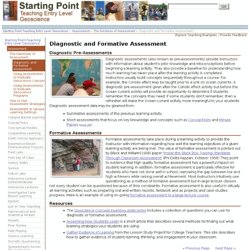
They also provide a baseline for understanding how much learning has taken place after the learning activity is completed. Instructors usually build concepts sequentially throughout a course. For example, the Coriolis effect may be taught prior to a unit on ocean currents. A diagnostic pre-assessment given after the Coriolis effect activity but before the Ocean current activity will provide an opportunity to determine if students remember the concepts they need.
Brown.pdf. Assessment for Learning: Home. The Assessment Reform Group. The Assessment Reform Group was a voluntary group of researchers brought together as the Policy Task Group on Assessment by the British Educational Research Association (BERA) in 1989.
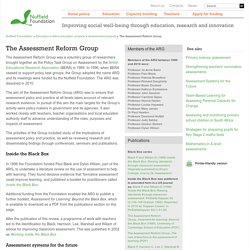
In 1996, when BERA ceased to support policy task groups, the Group adopted the name ARG and its meetings were funded by the Nuffield Foundation. The ARG was dissolved in 2010. The aim of the Assessment Reform Group (ARG) was to ensure that assessment policy and practice at all levels takes account of relevant research evidence. In pursuit of this aim the main targets for the Group’s activity were policy-makers in government and its agencies. It also worked closely with teachers, teacher organisations and local education authority staff to advance understanding of the roles, purposes and impacts of assessment. The Assessment Reform Group. 003. Defining the terms Assessment for Learning It is crucial to start off by clarifying the difference between what could be termed Assessment of Learning (i.e. summative assessment - often public exams) and Assessment for Learning - 'the process of seeking and interpreting evidence for use by learners and their teachers to decide where the learners are in their learning, where they need to go and how best to get there' (Assessment Reform Group 2002).
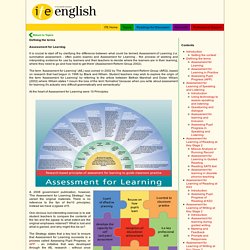
The term 'Assessment for Learning' (AfL) was coined in 2002 by The Assessment Reform Group (ARG), based on research that had begun in 1998 by Black and Wiliam. Student teachers may wish to explore the origin of the term 'Assessment for Learning' by referring to the article between Bethan Marshall and Dylan Wiliam (2002) where Wiliam states 'I mourn the loss of the term 'formative' because when you write about assessment for learning it's actually very difficult grammatically and semantically.' QUIZZES-TESTS-CLOZE. Assessment Platforms. Formative Assessment Strategies. Quick Key Mobile. Www.potsdam.edu/offices/ie/assessment/upload/Assessment_Glossary_of_Terms.pdf. Store.scholastic.com/content/stores/media/products/samples/21/9780545087421.pdf. Testing Information.
Testing is used in schools to measure student achievement.

State tests are given to students in a district once a year, based on their grade level and subject area. Classroom tests are given by individual teachers on a more regular basis and may include quizzes, mid-terms, chapter tests, and final exams, among others. Both types of tests give educators an idea of how well their students are learning the concepts presented to them in the classroom. State testing information (data) by district or school can be found using the Data Center link provided. Educators can use this testing information to adjust their instruction to increase how well their students retain what is being taught. Additional resources, including Item Samplers and Learning Point Navigator, are available on the Minnesota Assessments website.
Information on this page can help parents, caregivers, and students learn more about testing in Minnesota schools. Title I Assessments. Wps.pearsoned.co.uk/wps/media/objects/8970/9185376/65767_30_SuppI.pdf.
Minnesota State Standards for Language Arts: Grade 1 - Perma-Bound Books. Currently Perma-Bound only has suggested titles for grades K-8 in the Science and Social Studies areas.
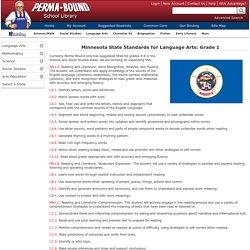
We are working on expanding this. MN.I.A. Reading and Literature: Word Recognition, Analysis, and Fluency: The student will understand and apply knowledge of the sounds of the English language (phonemic awareness), the sound-symbol relationship (phonics), and word recognition strategies to read grade-level materials with accuracy and emerging fluency. Easy test makers. Types of Rubrics - Teaching Commons.
There are three common types of rubrics: Analytic Rubrics An analytic rubric resembles a grid with the criteria for a student product listed in the leftmost column and with levels of performance listed across the top row often using numbers and/or descriptive tags.
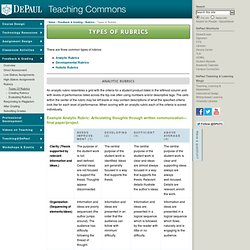
The cells within the center of the rubric may be left blank or may contain descriptions of what the specified criteria look like for each level of performance. When scoring with an analytic rubric each of the criteria is scored individually. Example Analytic Rubric: Articulating thoughts through written communication— final paper/project. Advantages of Analytic Rubrics Provide useful feedback on areas of strength and weakness. Disadvantages of Analytic Rubrics Takes more time to create and use than a holistic rubric. [Back to top] Developmental Rubrics Developmental rubrics are a subset of analytic trait rubrics.
Generally, this type of rubric would be based on a theory of development. Www.uni.edu/chfasoa/analyticholisticrubrics.pdf. Www.ets.org/flicc/pdf/Formative_Assessment_presentation. Questioning.